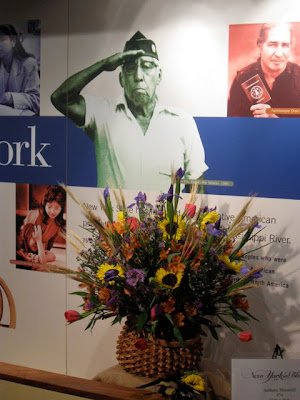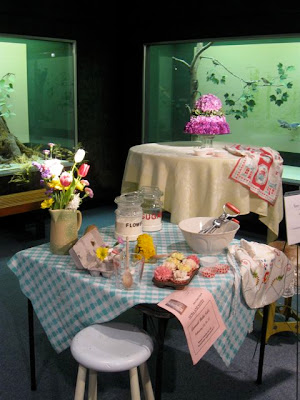 The State Museum's permanent Adirondack Wilderness exhibit includes a section highlighting the various minerals found in New York State. My subjective impression is that Minerals of New York is one of the most popular displays; men, in particular, seem to relish looking at the geological specimens, but a lot of women (myself included) are also drawn to it.
The State Museum's permanent Adirondack Wilderness exhibit includes a section highlighting the various minerals found in New York State. My subjective impression is that Minerals of New York is one of the most popular displays; men, in particular, seem to relish looking at the geological specimens, but a lot of women (myself included) are also drawn to it.This simple yet stunning arrangement of "Lilac Shock" gladiolus, created by Andrew Koehn of Mohonk Mountain House, greeted visitors at the western entrance to the minerals display.
 I love white and green floral arrangements, and this composition of miniature lilies, carnations, spray roses, gladiolus, calla lilies, myrtle, seeded eucalyptus, leather leaf, and tulips pleased me deeply. Anna Munafo of Price Chopper Central Market Florist created it.
I love white and green floral arrangements, and this composition of miniature lilies, carnations, spray roses, gladiolus, calla lilies, myrtle, seeded eucalyptus, leather leaf, and tulips pleased me deeply. Anna Munafo of Price Chopper Central Market Florist created it. Craig T. Waltz, Jr., of Fleurelite Floral Design created this amazing arrangement of oncydium orchids, king protea, pincushion protea, ti leaves, heliconia, winter flame dogwood, and monstera leaves. It's beautiful and just a bit alien -- just like some of the adjacent geological specimens.
Craig T. Waltz, Jr., of Fleurelite Floral Design created this amazing arrangement of oncydium orchids, king protea, pincushion protea, ti leaves, heliconia, winter flame dogwood, and monstera leaves. It's beautiful and just a bit alien -- just like some of the adjacent geological specimens. The Native Peoples of New York gallery is one of two galleries on the south side of the State Museum. This arrangement by independent floral designer Anthony Macarelli sat at the gallery entrance. Sunflowers, Alstromeria, statis, iris, tulips, and monte casino asters sit in a basket that resembles the Iroquois baskets on display in the gallery.
The Native Peoples of New York gallery is one of two galleries on the south side of the State Museum. This arrangement by independent floral designer Anthony Macarelli sat at the gallery entrance. Sunflowers, Alstromeria, statis, iris, tulips, and monte casino asters sit in a basket that resembles the Iroquois baskets on display in the gallery. This arrangement, created by Susan Peter of Bud's Florist and Greenhouse, sits outside a replica Iroquois longhouse -- which is a perennial favorite of young visitors. Information about the composition of this arrangement was not available.
This arrangement, created by Susan Peter of Bud's Florist and Greenhouse, sits outside a replica Iroquois longhouse -- which is a perennial favorite of young visitors. Information about the composition of this arrangement was not available. Audrey Hawkins and Melissa Palmer of the Fort Orange Garden Club produced an arrangement that blends beautifully with the section of the gallery devoted to Iroquois baskets. It feature leucodendron, St. John's Wort, Peruvian lilies, pittosporum, huckleberry, zebra grass, bear grass, and bunny tail.
Audrey Hawkins and Melissa Palmer of the Fort Orange Garden Club produced an arrangement that blends beautifully with the section of the gallery devoted to Iroquois baskets. It feature leucodendron, St. John's Wort, Peruvian lilies, pittosporum, huckleberry, zebra grass, bear grass, and bunny tail. And this arrangement, by Pamela Nagengast of Emil J. Nagengast Florist, perfectly complements the Iroquois beadwork display. It consists of dendrobium orchids, matsumoto aster, trichillium, curly willow, thistle, statice, and miniature Gerbera daisies.
And this arrangement, by Pamela Nagengast of Emil J. Nagengast Florist, perfectly complements the Iroquois beadwork display. It consists of dendrobium orchids, matsumoto aster, trichillium, curly willow, thistle, statice, and miniature Gerbera daisies. The remainder of the State Museum's South Hall is home to a permanent exhibit on Ancient Life in New York and a Photography Gallery and Exhibition Hall that feature temporary exhibits. At present, the Photography Gallery is home to Farmers, Warriors, Builders: The Hidden Life of Ants.
The remainder of the State Museum's South Hall is home to a permanent exhibit on Ancient Life in New York and a Photography Gallery and Exhibition Hall that feature temporary exhibits. At present, the Photography Gallery is home to Farmers, Warriors, Builders: The Hidden Life of Ants.Unfortunately, I neglected to note the name of the creator of this exhibit or any details about its composition. However, I liked it so much that I'm including it in this post. From the top, it looks very much like a traditional, pleasingly springlike arrangement. However, the globe at the bottom, which brings to mind ant habitat, is an unexpected and interesting touch.
 This composition of pincushion protea, equisetum, lemon leaf, safari sunset, speckled aspidistra, dendrobium orchids, seaster fern, green spider mums, bird of paradise, and song of India visually echoes the spindly ant on the far wall. It was created by Dan Foley of the Bethlehem Garden Club.
This composition of pincushion protea, equisetum, lemon leaf, safari sunset, speckled aspidistra, dendrobium orchids, seaster fern, green spider mums, bird of paradise, and song of India visually echoes the spindly ant on the far wall. It was created by Dan Foley of the Bethlehem Garden Club. The image is a little out of focus, but the arrangement is too good to omit: independent floral designer Anthony Macarelli's ants survey their peers on the wall. The ants and their habitat are comprised of statis, assorted mosses, anturium, bromeliads, succulents, pine cones, seed pods, burning bush, and peanut shells.
The image is a little out of focus, but the arrangement is too good to omit: independent floral designer Anthony Macarelli's ants survey their peers on the wall. The ants and their habitat are comprised of statis, assorted mosses, anturium, bromeliads, succulents, pine cones, seed pods, burning bush, and peanut shells. At present, the Exhibition Hall is home to Citizen Soldier: New York's National Guard in the American Century. Peter Scranton of the Schenectady ARC created this arrangement of delphinium, tulips, carnations, spider mums, and pittisporum for the exhibit entrance, which features an M8 Greyhound Light Armored Car used during the Second World War.
At present, the Exhibition Hall is home to Citizen Soldier: New York's National Guard in the American Century. Peter Scranton of the Schenectady ARC created this arrangement of delphinium, tulips, carnations, spider mums, and pittisporum for the exhibit entrance, which features an M8 Greyhound Light Armored Car used during the Second World War. The Crossroads Gallery is in the East Hall, which is almost completely given over to a permanent exhibit documenting the development of New York City. However, it is used to house temporary exhibits. At the moment, it is home to The Landscape of Memory - Prints by Frank C. Eckmair. Eckmair's work focuses on the rural landscapes of central New York; if you're so inclined, the online companion to the exhibit will give you a tantalizing taste of his work.
The Crossroads Gallery is in the East Hall, which is almost completely given over to a permanent exhibit documenting the development of New York City. However, it is used to house temporary exhibits. At the moment, it is home to The Landscape of Memory - Prints by Frank C. Eckmair. Eckmair's work focuses on the rural landscapes of central New York; if you're so inclined, the online companion to the exhibit will give you a tantalizing taste of his work.On Thai of Surroundings Floral Studio used forsythia, roses, dianthus, leucodendron, lily, sellum, philodendron, aspidistra, bear grass and galas leaves to complement the entrance to the exhibit.

The Bird Hall, which sits between the East and West Halls and immediately to the north of the South Hall, houses the permanent Birds of New York exhibit.
It's a New York in Bloom tradition to devote the Bird Hall to floral roomscapes, and Kimberly Seymour of Embellir used her alloted space to create a country kitchen comprised of carnations, roses, tulips, statice, daisies, and buttom mums. Check out those carnation cupcakes!
 Benjamin Hodder of Frame of Light produced a sophisticated dining room featuring variegated aspidistra, roses, carnations, Gerbera daisies, birds of paradise, pincushion protea, asters, and delphinium.
Benjamin Hodder of Frame of Light produced a sophisticated dining room featuring variegated aspidistra, roses, carnations, Gerbera daisies, birds of paradise, pincushion protea, asters, and delphinium. This impressive array of tablescapes -- one for each month of the year -- was created by Barbara Guyette, Charles Guyette, and Linda Savage of W&P Enterprises. It features white wax flowers, blue juniper, dried cattails, grasses, yarrow, spray roses, white lilies, kalanchoe, red roses, white mums, purple statice, red carnations, blue spruce, and blue juniper.
This impressive array of tablescapes -- one for each month of the year -- was created by Barbara Guyette, Charles Guyette, and Linda Savage of W&P Enterprises. It features white wax flowers, blue juniper, dried cattails, grasses, yarrow, spray roses, white lilies, kalanchoe, red roses, white mums, purple statice, red carnations, blue spruce, and blue juniper.





No comments:
Post a Comment